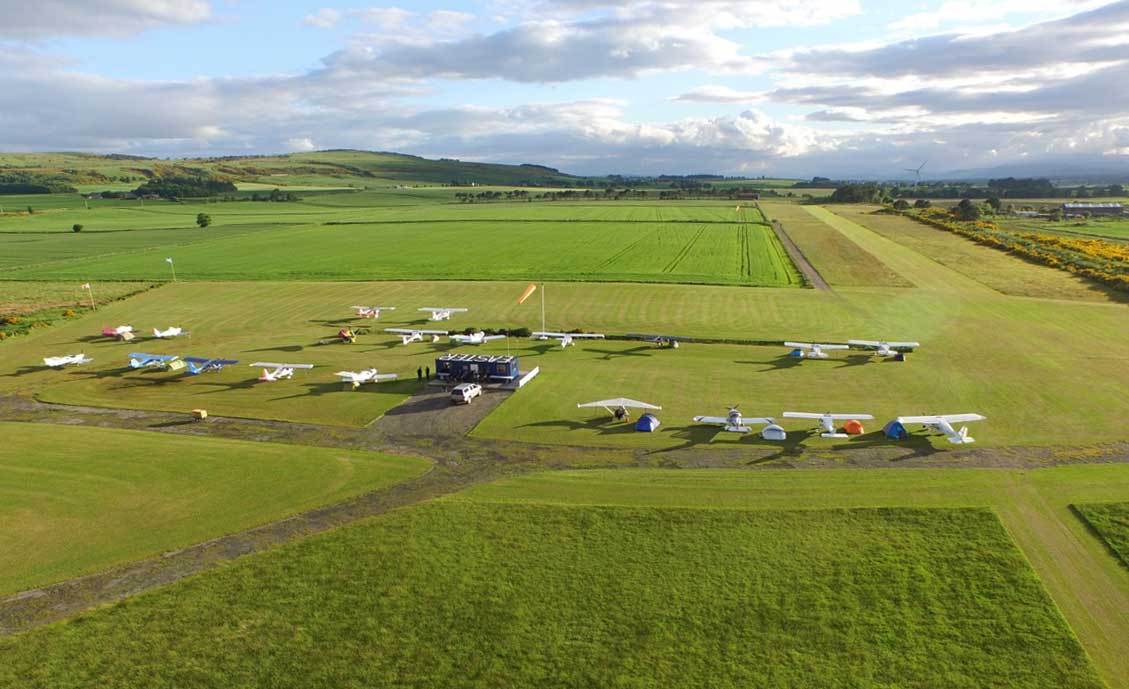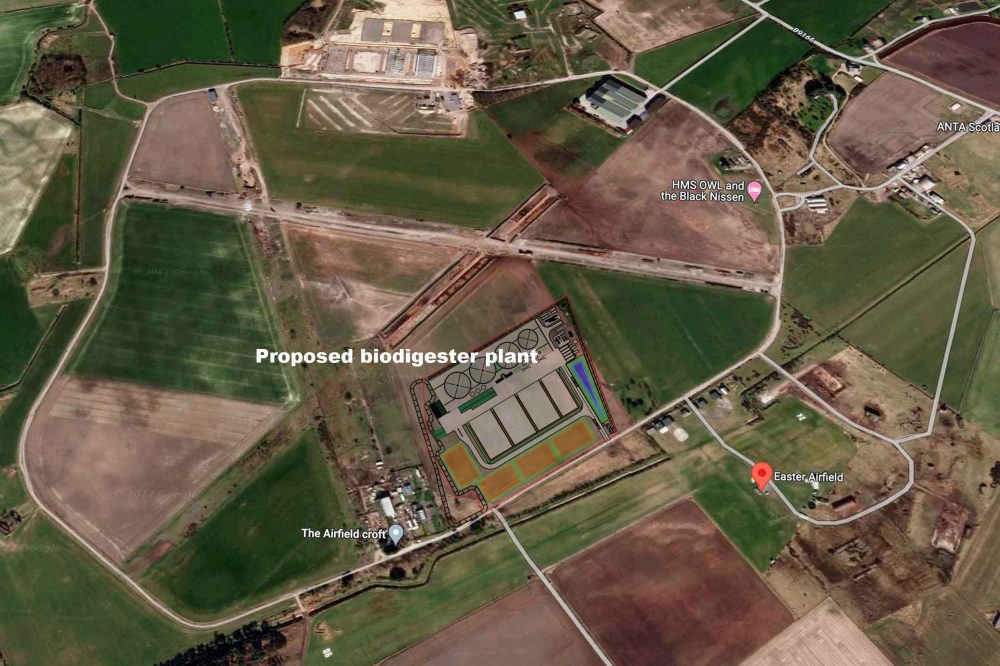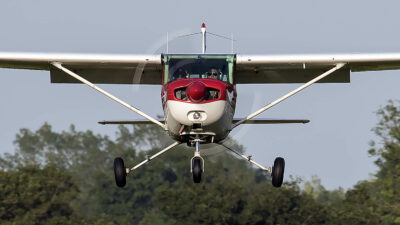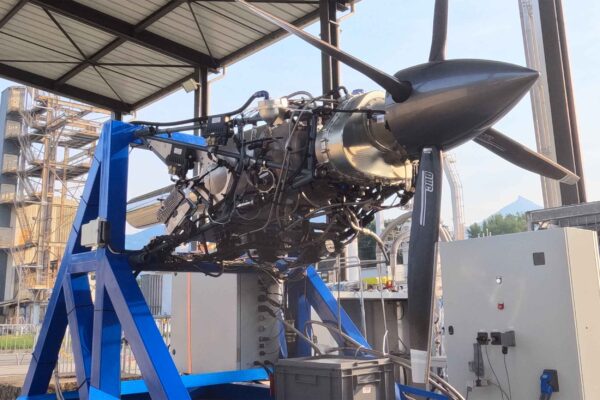Easter Airfield – and local residents – is fighting a plan to build a biodigester plant 40 metres from the centre of its runway.
The CAA’s Airfield Advisory Team has already responded to the proposal, objecting on several grounds. Problems created by a similar digester plant close to Inverness Airport are cited in the CAA’s response.
The proposal is for the ‘Erection and operation of an anaerobic digestion plant and ancillary infrastructure’ in a southern corner of the former RNAS Fearn site which adjacent to Easter Airfield.
The plant will be operated by Acorn Bioenergy and includes:
- Gas Flare
- Biogas Upgrading & CO2 Recovery Unit
- Feed Hopper
- Grid Entry Unit
- Heat Exchanger
- Chiller
- CO2 Tanks
- Rainwater Lagoon
- Silage Clamps
- Digestate Storage Lagoons.
It will have a generating capacity of 100GW per year, according to the application. When operating, there will be an estimated 65 daily movements of vehicles including 18 tankers.

The simply stunning Easter Airfield… anaerobic digester plant would be to the right of the runway
Easter Airfield’s David Edes said, “We, along with nearly every local resident, will be objecting to this on various grounds. Ours is simple – on the grounds of safety!”
That view is supported by the CAA’s Airfield Advisory Team: “We observed the site notices at the two anaerobic digestion sites local to Inverness Airport warning of explosive atmospheric conditions associated with the operation of such sites.
“It is understood that the proposed site will require to vent gas and/or flare at times. The timing, frequency and heat energy produced by such functions is not understood and therefore cannot yet be assessed. This is an important consideration for aviators as rising heat can impact aircraft in flight causing turbulence and potentially, aircraft control challenges and engine power changes.
“With the proposed development so close to the aerodrome, such phenomena could occur when aircraft are in flight, at low level and low speeds. These are the most critical phases of flight.”
The CAA also points out the wildlife hazards created by large bodies of water and the “significant and unpleasant smell emanating from both the anaerobic digestion sites local to Inverness Airport”. Both features are likely to attract wildlife including large birds of prey.
The planning application reference number is 22/05178/FUL and can be viewed and commented upon at The Highland Council planning portal here.

Developer’s image of the anaerobic digester plant. Easter’s runway is just the other side of the trees in the background

Context
Construction of the aerodrome began in 2007 and first flights commenced in 2008. The site has since evolved steadily with the addition of hangarage and a runway extension making Easter Airfield an important destination of choice for a variety of general aviation stakeholders. These include private owner operators, both those based at the aerodrome and those visiting the region, as well as approved flight training organisations. Additionally, Easter Airfield has become increasingly popular with flights which provide added value to the local economy, bringing private customers directly to the highlands for the local golf courses, whiskey distilleries, shooting and fishing etc. These points serve to demonstrate the viability and thriving nature of the aerodrome operation.
Proximity of site location to active and established aerodrome
The proposed site location is just 40 metres to the north of aerodrome infrastructure and is abeam the mid-point of the runway. Aircraft operating at Easter Airfield carry out circuit training at various levels which brings both the anaerobic digestion facility and aviation operations in proximity. Such flight training requires repetitive circuit and “go arounds” (aborted landing attempts) which as standard, requires the aircraft to take up a track parallel and to the right of the runway before re-joining the circuit pattern. During these frequent and standard training scenarios, such aircraft would fly even closer to the proposed development site at heights well below 500ft.
Additionally, it is important to point out the diverse range of aircraft that use the aerodrome. These are not limited to fixed wing aircraft only. Rotary wing aircraft including helicopters and autogyros also use the aerodrome and fly different tracks to the fixed wing aircraft. Direct arrival and departure tracks, as well as autorotation training would see such aircraft fly directly over the proposed development site whilst descending as part of pilot training.
Explosive atmospheres at such sites
We observed the site notices at the two anaerobic digestion sites local to Inverness Airport warning of explosive atmospheric conditions associated with the operation of such sites.
Flaring, gas venting and thermal plume
It is understood that the proposed site will require to vent gas and/or flare at times. The timing, frequency and heat energy produced by such functions is not understood and therefore cannot yet be assessed. This is an important consideration for aviators as rising heat can impact aircraft in flight causing turbulence and potentially, aircraft control challenges and engine power changes. With the proposed development so close to the aerodrome, such phenomena could occur when aircraft are in flight, at low level and low speeds. These are the most critical phases of flight. Additionally, we observed other heat generating / emitting infrastructure associated with the operation of local anaerobic digestion plants such as radiators / refrigerant units. These units could also contribute to rising thermal plumes. As already stated, the warning of explosive atmospheres collocated with dynamic flaring is alarming. Furthermore, it is possible that dynamic flaring could pose a sudden distraction to pilots, particularly in low light conditions.
Wildlife and habitat management
Aerodromes work hard to monitor wildlife to reduce the likelihood of wildlife strikes, which are a significant hazard to aircraft operations. We were surprised by the significant and unpleasant smell emanating from both the anaerobic digestion sites local to Inverness Airport. We understand that the proposed site includes several bodies of water which raises key safety concerns as water attracts a variety of wildlife species, from waterfowl and small invertebrates which in turn, attract larger birds of prey. The smell was overpowering and whilst not an aviation safety concern, it invites questions as to how the source of the smell and material used for the operation of the site, could attract wildlife and thus, seems to be in direct conflict with safeguarding strategies at Easter Airfield. At the two anaerobic digestion sites local to Inverness Airport, we noted significant evidence of material contained in what looked to be compression hoppers and storage bunds. Also, material detritus which evidently, appears difficult to contain and subsequently, was strewn around the site, all of which represent a wildlife attraction hazard.
Build Phase and ongoing maintenance of the anaerobic digestion facility
The proposed development of the scheme includes the transformation of the current site and surroundings with multiple large digestion tanks, other outbuildings, trenches and ditches, and flaring tower etc. The build phase of the proposed facility will impact aviation operations with cranage representing vertical obstructions which are a key concern. Earth works also represents a change in local habitat and will attract wildlife during the build phase. It is logical that the site will require ongoing operational maintenance. When such occurrences arise, additional disruption could be caused to the Easter Airfield operation where craning is required.
















1 comment
I find it difficult to understand why of all the places this needs to be put right here? Easter Airfield is not only a stunning and admired location, it also attracts pilots from all over the country, and putting this system in this place is not only irrational, but also dangerous. There are enough airfields and airports under threat, to add this one to the list. SURELY there must be a reconsideration for the location?